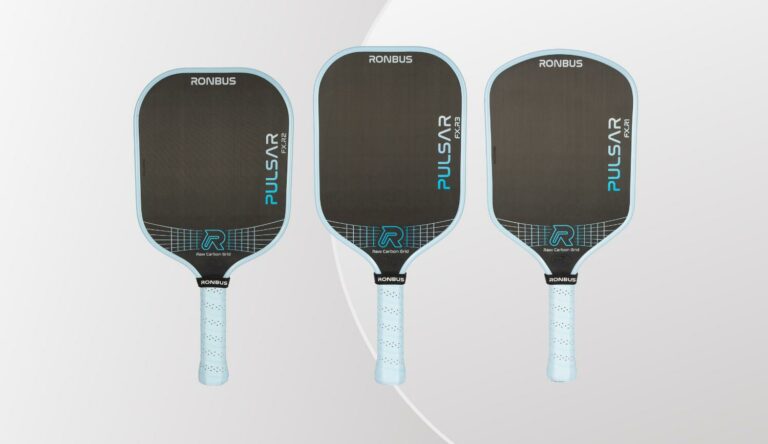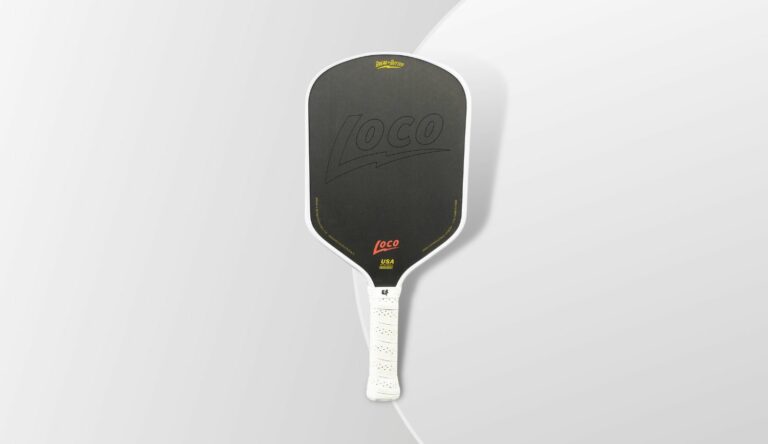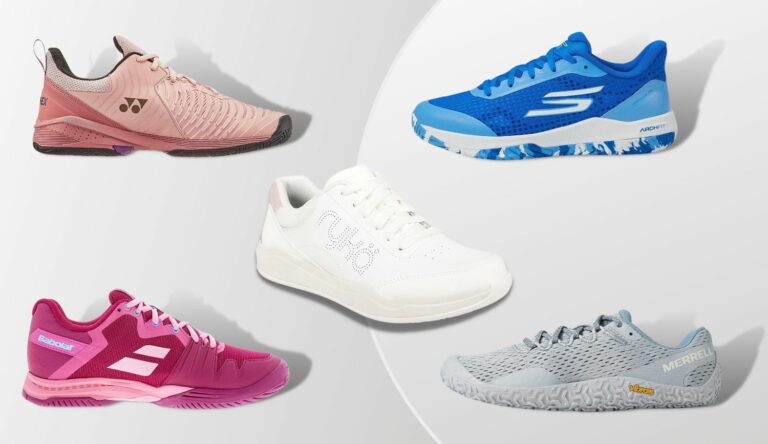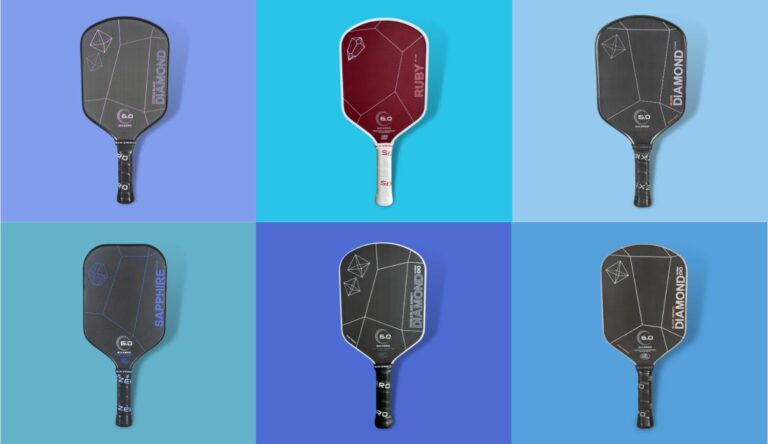Ben John’s started using the Perseus prototype paddle in late 2022 and mentioned the paddle on an Instagram post on January 12th, 2023. Ben and a handful of testers fine-tuning this paddle with the Joola R&D team for months.
The paddle was finally released on June 12th and is be one of the most popular releases of this year.
Contents
Joola Perseus Technical Specifications
- Price: $249.95
- Type: Power/All-court
- Shape: Standard/elongated
- Core thickness: 16mm & 14mm versions
- Face: Raw Toray T700 raw carbon fiber w/ textured finish
- Average weight: 8.0 oz
- Grip length: 5.5”
- Swing Weight: 116 (16mm) 112 (14mm)
- Grip size: 4.25” (16mm) 4.125″ (14mm)
- Core: “Reactive” polypropylene honeycomb (Same as in the Hyperion line)
- Total length: 16.5”
- Width: 7.5”
- Warranty: 6 months for manufacturer defects
Joola Perseus Quick Summary
The Perseus paddle is Joola’s first unibody thermoformed paddle (which they refer to as “fully encased/carbon-wrapped technology”). It’s an elongated power-focused paddle with all-court control capabilities. While the thermoforming and their new “charged carbon surface” makes it feel stiffer than the Hyperion, the Perseus utilizes the same foam-injection perimeter weighting as the Hyperion to ensure a solid sweet spot.
On the surface, the Perseus doesn’t look too much different from the Hyperion. The paddle face aesthetics even looks similar. They both share the same 5.5″ elongated length handle and the same total length. The biggest difference is that the Perseus has a more traditional elongated face that’s more square, while the Hyperion has a more rounded/hybrid top. The impressive thing about this is that the Perseus feels lighter and quicker in hand than the head-heavy Hyperion., even with the more square-topped face.
Power
I really like the power of the Perseus. It felt good on speedups and drives. My serves hit plenty hard and deep right out of the gate. I think Joola’s new unibody thermo production methods have provided the power that was lacking in their last models.
The Perseus is firm, stiff, and pretty poppy, which makes it stand out compared to softer and less poppy Hyperion line. The Perseus is definitely a better paddle for power output, making it a great option for singles.
The Perseus doesn’t have the same power as some of the prominent thermoformed paddles that have come out in the past six months. It doesn’t hit as hard as the Six Zero Black Diamond or CRBN 1X. The 14mm has more power and puts it on par power-wise with some of the mid-range thermoforms such as the Vatic Pro Flash, Double Black Diamond, Ronbus R3 Pulsar., and the newer Legacy Pro.
Control
The Perseus doesn’t feel as soft and easy to control as the Hyperion. This isn’t too much of a surprise, as the Hyperion is a Gen.1 paddle that doesn’t have the stiffer feel of a unibody thermoformed paddle. The soft spot on the Hyperion is massive and the feel when it hits a ball is very plush. The Perseus feels stiffer and poppier, and the sweet spot is not as large and inviting.
Dropping, blocking, resetting, and dinking felt good on the Perseus, albeit not quite as good as with some other thermoformed paddles, like the Electrum Model E Elite and Ronbus R3 Pulsar. And then there’s the Hyperion, which is on another tier of controllability.
As mentioned, I found the size of the sweet spot on the Perseus is a little underwhelming, especially on the 14mm. I play a lot with the R3 Pulsar, Double Black Diamond, Legacy Pro, and Vatic Pro V7, and all of those thermoformed paddles have really big sweet spots that are more forgiving than the Perseus. You get a clunk sound and a dead ball when you hit off-center with the Perseus. I can hit those same areas of the paddle with those other models I mentioned and still get a great, consistent shot.
If your main paddle has been the Hyperion and you’re switching to the Perseus, be prepared for your soft game to feel a little challenging at first. Some balls will die off a bit when hit that would otherwise be fine with the soft plow-through of the Hyperion.
With that said, it didn’t take me too long to adjust to the stiffer Perseus, and the added benefits of increased pop and power made it worth it for me.
Spin
Like the Hyperion, the Perseus’s spin is good but not great. It seems to be using the same sort of gritty texture on the paddle face as the Hyperion. There could be some modifications, but I can’t tell exactly.
I’ve played with a lot of high-spinning paddles over the past 6 months, and one commonality that I’ve found with the top-tier paddles for spin is that they’re focusing more on friction than grit. Some of the top spinning paddles I’ve used don’t actually have much grit at all, but instead, feel subtly grippy and frictiony on their relatively smooth surfaces.
This friction seems to grip the balls better than the gritty surfaces I see on paddles like the Perseus. Their paddle faces also retain their high-spin capabilities longer than gritty paddles. The Hyperion line tended to lose its spin potency relatively quickly, and I assume it will be similar for the Hyperion.
The grit on my Perseus also feels a bit inconsistent across the paddle face and is also different on each side of the paddle. I’m sure this was not intentional but is not uncommon for their paddles.
Overall, the Perseus feels like it has a bit more spin than the Hyperion, but it doesn’t wow me like the Ronbus Pulsar, Legacy Pro, Vatic Flash, and Six Zero Double Black Diamond do. That doesn’t mean it doesn’t spin the ball well. I get plenty of topspin and my backspin feels really good with the Perseus. It’s just not top-of-the-line.
Pop
The Perseus is more poppy than any other Joola paddle that I’ve played with. The ball doesn’t sit on the face very long at all, especially compared to the Hyperion. The Perseus has high pop, but is less poppy than the Black Diamond line and CRBN Power series line. I’d put it on the same level as the Vatic Pro Flash.
The ball rockets off the paddle fast due to the high pop, but it doesn’t have the deeper power feel of a full swing on the Hyperion. The Hyperion is less poppy, and thus it’s able to generate more plow-through on the ball before it leaves the face.
The Perseus’s pop is great for playing fast and hard but makes soft game shots like dinks and resets require just a bit more focus than with the Hyperion.
Hand speed
The Perseus paddle is significantly lighter and easier to swing than Ben John’s previous signature paddle, the Hyperion CFS.
The Hyperion CFS 16mm is notoriously head heavy and slow to swing with a 127 swing weight. The Perseus 16mm is down to 116 swing weight and feels notably quicker in my hands. The Hyperion Swift 16mm is still marginally lower on the swing weight scale, but so little that it’s hard to notice, and the Perseus is a far superior paddle than the swift version.
The 14mm is down to a swing weight of 112, which is also very fast. It feels on par with the 14mm Hyperions, which are both pretty fast in hand.
Durability
Ben John’s last signature paddle, the Hyperion, has notorious durability issues. The handle on these paddles tends to break easily. I’ve had two break on me and know people who’ve had three or more break. Joola replaced all these paddles, but it was a drag.
Unlike the Hyperion, the Persues paddle is unibody thermoformed, so there’s not two pieces connected together at the handle like with the Hyperion. This should ensure that the handle-breaking phenomenon doesn’t extend into their newest Perseus line.
Another hot durability topic is the delamination and core-crushing that’s been happening with thermoformed paddles. Joola is confident that their new fully-encased thermoformed Perseus should not encounter these issues. They feel this way because they used the same type of thermoforming for the paddle face of the non-unibody Hyperion, and it did not suffer from widespread delamination or core-crushing issues.
Value
If you’re looking for the best bang for your buck, the Perseus is a pretty steep buy at $250.
There are some great paddles available that are very similar, and in some ways better, than the Perseus for less. If you’re into thermoformed paddles, then I highly recommend the Six Zero Black Diamond, Legacy Pro, Ronbus Pulsar, and Vatic Pro. You can use the promo code DASHPB to get an additional 10% off of these paddles.
14mm Perseus vs. 16mm Perseus
The 16mm is Ben Jon’s signature paddle and his preferred thickness. Most players typically go with the 16mm version of the paddle. It’s more forgiving than the 14mm with its increased stability and bigger sweet spot, which makes it the better option for touch and resets.
The 14mm is best for players who prioritize speed, power, and quick hands. You will get more pop and power with the 14mm over the 16mm, but you will lose a notable amount of stability and forgiveness. Blocks are a bit harder with the 14mm due to the drop in stability.
I mostly play with the 16mm Perseus over the 14mm. But if there’s one thing I could take from the 14mm and put on the 16mm, it would be the smaller grip size. The 14mm uses a 4.125″ grip size, which is my preferred size, while the 16mm uses a 4.25″ grip size.
Should you buy the Joola Pursues Paddle?
If you like Joola and are excited to play with the newest and most advanced paddle in their lineup, then I think you should absolutely pick up a Perseus paddle today. The Perseus and Scorpeus paddles lines are going to be mainstays for the next year and beyond. The idea of playing with Ben John’s curated paddle of choice also adds to its intrigue.
I’ve been happy with my time with the Perseus and will continue to use the paddle regularly. The Perseus fixes two of the biggest problems I had with the Hyperion – the durability issues and the head heaviness/high swing weight.
If you’re switching from the Hyperion, you’ll be getting a harder-hitting, quicker-moving, poppier, and more durable paddle at the expense of some soft game and control. Because of this, I recommend the Perseus to more intermediate players and advanced players. With the smaller sweet spot, you need to be a bit more precise.
If you’re on the fence about spending $250 for a paddle, then I’d highly recommend checking out some of the cheaper thermoformed paddles I’ve mentioned already in this article, like the Ronbus Pulsar, Legacy Pro, Vatic Flash, and Six Zero Double Black Diamond. The Perseus is a different paddle from them, for sure, but also similar. And these paddles all have better spin, bigger sweet spots, and are priced more attractively than the Perseus.
If you’d like to improve your pickleball game, check out my posts on beginner pickleball tips, singles pickleball tips, and how to prepare for pickleball a tournament.







10 thoughts on “Joola Project Perseus Pickleball Paddle Review (Ben John’s New Pro Paddle)”
Ben John’s old racquet was good but it’s the quality that causes the problem in a way the surface is a carbon t 800 so cheap, compare to the t 700 which keeps its grip longer, the surface stops at the beginning of the shaft the delamination, the delamination of the shaft, the grip which is royally lacking for the price we should expect a better paddle on mine the roughness lasted 3 months that’s expensive paddle today I am 6 months and I have delamination areas that do not respond well or are dead but for such a weight I must admit it is very well balanced and still responds well I ordered a legacy pro hoping for a better quality
Denis
Yeah, for the price, the Hyperion doesn’t hold up amazingly. Still a great paddle, but I think you’ll be happier with the feel and quality of your Legacy Pro, especially considering its price.
any other specs that you can give to us. i would like to know the thickness of the paddle and the length of the handle. GO PICKLE! ……anna
I do love my Hyperion 16mm,. I sent 2 back bc of the cracked edging, but I have been playing with my current paddle for a year and a half. I feel like it isn’t quite as responsive as it was, but love the power and touch I have with this paddle. I was going to buy a new one, but thinking about waiting for the Perseus! Would love to see more Joola women’s apparel too! Always looking for a nice looking outfit to wear on the court. ~Paula
waiting on perseus, would love to see Joola come out with a competition ball that is a bit firmer than the primo. match the ball to the paddle technology
Super excited for this new Joola paddle. The release date is 6/6/23, does this mean we can order with overnight shipping ?
I’ll have a link to JustPaddles, who will be selling on 6/6. Hopefully with a discount code.
Hi, no question JOOLA recognized that they needed to get an entry into the raw carbon fiber “gen 2” market to compete with the likes of Legacy Pro, Six Zero etc. and distance themselves from the questionable quality and durability of the Hyperion paddles After seeing the commercial release of the Perseus line I was disappointed that the graphics and color schemes were simply a redux of the Hyperion. I thought the graphics of the prototype Perseus alpha 1 pictured in your article was much cleaner, cooler, and represented something fresh and new. The graphics on the paddle for the public seem dated and too similar to the previous line. Is the Perseus alpha 1 a different paddle to the commercial release and any chance they make that version with those prototype graphics to the masses? Thanks.
Hey, Jimmy. I completely agree on the graphics. I prefer the Alpha version. I doubt they’re going to release the original graphics to the masses, unfortunately.
Most of the guys who I’ve played with would never buy another Joola after playing with the OG Hyperion. Between Hyperion grit sheering off, the price and quality, there is no going back to Joola. Now more so than ever, considering there are better reviewed paddle out there for 30-40% less.